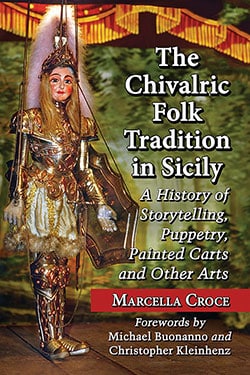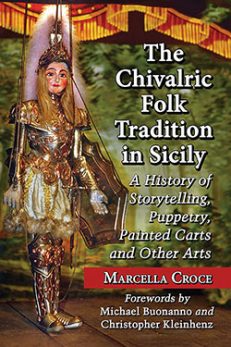The Chivalric Folk Tradition in Sicily
A History of Storytelling, Puppetry, Painted Carts and Other Arts
$35.00
In stock
About the Book
Tracing the development in Sicily of a chivalric tradition based on the medieval stories of Charlemagne and his knights, this is an analysis of Sicilian storytelling, puppetry, festivals, cart painting and other folk art. Interviews with puppeteers are documented, and hand painted cart panels and playbill posters are described and illustrated. The diffusion of the chivalric tradition in Sicily is explained in part by the “sense of honor” that has permeated Sicilian life. The story of one puppeteer, Girolamo Cuticchio, and his family sheds light on the hardships and uncertain future of this art.
About the Author(s)
Bibliographic Details
Marcella Croce
Format: softcover (6 x 9)
Pages: 240
Bibliographic Info: 36 photos (21 in color), appendix, notes, bibliography, index
Copyright Date: 2014
pISBN: 978-0-7864-9415-6
eISBN: 978-1-4766-1731-2
Imprint: McFarland
Table of Contents
Table of Contents
Acknowledgments xi
Foreword by Michael Buonanno 1
Foreword by Christopher Kleinhenz 3
Preface 7
One • From the Middle Ages to the Puppets 11
Introducing Sicily—A Mosaic of Cultures 11
The Chivalric Stories Through the Centuries 13
The Chivalric Tradition in Sicily Before the Renaissance 15
The Success of Chivalric Romances in Sicily in the 16th Century 20
Problems on the Origin of the Sicilian Puppet Show 22
Two • The Oral Tradition 23
The Chivalric Tradition Between Learned and Popular Literature 24
The Role of the Storyteller in the Osmosis Process Between
Dominant and Subordinate Cultures 26
Three Types of Traditional Storytellers: Chivalric Tales, Sacred
Stories and Chronicles 27
The Tradition of Blind Storytellers (Orbi) in Palermo 29
The Traditional Epic Storytellers in Sicily and in Naples 32
Sicilian Traditional Epic Storytellers in the Past and in the Present 34
Traces of the Chivalric Tradition in the Language of the Sicilian
People—Idiomatic Expressions and Proverbs 38
Toponyms and Family Names 40
Three • The Celebrations 42
A Carnival Pantomime with a Knight: The Mastro di Campo 43
Dancing with Swords and a Holy Virgin in Arms 47
Chivalric Stories with Drums and Bells in Monforte San Giorgio 51
Four • The Puppet Shows 53
The Sicilian Puppet Shows in a Nutshell 53
Puppets or Marionettes? The Opera dei Pupi and the Sicilian Dialect 59
The Climax of the Sicilian Puppet Shows: The Famous Legendary
Battle of Roncevaux 61
Roncevaux in Lodico’s Book 62
Roncevaux on the Stage of the Sicilian Puppet Shows 65
The Rout of Roncevaux in the Ideology of the Opera dei Pupi 71
The Puppet Shows as “Necessary Art” of the Sicilian People 76
Five • A Family of Puppeteers 82
Presentation of Girolamo Cuticchio and His Family 82
Story of the Family—Girolamo as an Apprentice Puppeteer 83
A Puppeteer Is Born 85
Crisis and Revival of a Passion 88
Little Puppeteers Grow Up 91
Two Artisans’ Workshops in Giacomo Cuticchio’s Memories 93
Once Upon a Time: The Corte delle Stelle Theater in Cefalù 97
Between pages 100 and 101 there are 16 color plates
containing 21 photographs
Six • The Playbills (Cartelloni) of the Puppet Theater 101
Definitions of Folk Art and Peculiar Characteristics of Sicilian
Folk Art 101
Chivalric Subjects for Sicilian Folk Art 105
The Rout of Roncevaux in Playbill Posters for the Puppet Shows 107
Seven • The Sicilian Painted Carts 118
The Sicilian Carts in a Nutshell 118
History of the Cart 119
Makers of the Cart 129
The Cart Builder and the Sculptor 131
The Metal Worker 135
The Painter 137
Chivalric Subjects Painted on the Carts Belonging to the Pitrè
Museum in Palermo and to the Palazzo d’Aumale Museum
in Terrasini 146
The Maker of Horse Trappings 152
The World of the Cart Drivers 154
The Feast of St. Joseph in Bagheria 158
The Cart as a Sicilian Symbol 160
Lights and Shadows on the Sicilian Carts 165
Other Objects for Chivalric Subjects and Revival in Today’s Folk Art 169
Conclusions 173
Appendix: The Puppets and Their Stories 175
Chapter Notes 191
Bibliography 199
Index 207
Book Reviews & Awards
“A little gem… invaluable”—Studies in Medieval and Renaissance Teaching







